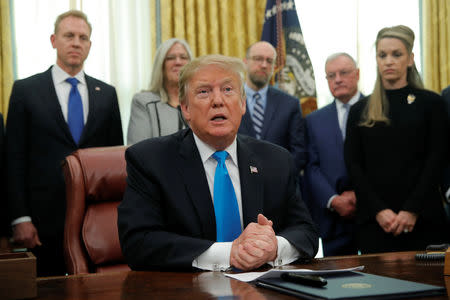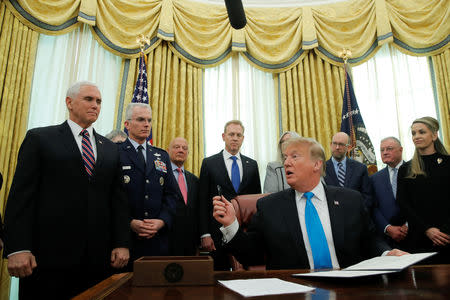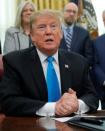Trump signs directive in step to create U.S. Space Force
By Mike Stone and Jeff Mason
WASHINGTON (Reuters) - Republican U.S. President Donald Trump on Tuesday signed a directive to start the lengthy process of creating a new branch of the military dedicated to handling threats in space, the U.S. Space Force.
Space Policy Directive 4 sets the foundation for a legislative initiative to establish a new force under the aegis of the Air Force, the branch currently responsible for space, comparable to the Marines under the U.S. Navy.
The Trump administration has said it plans to usher in the force by 2020. But the legislation will have to be approved by Congress, which could be an uphill battle with the House of Representatives now controlled by Democrats.
In an Oval Office signing ceremony on Tuesday, the president called the Space Force a national security priority.
Among other things, the force will be responsible for a range of space-based U.S. military capabilities, which include everything from satellites enabling the Global Positioning System (GPS) to sensors that help track missile launches.
The force would have both "combat and combat support functions to enable prompt and sustained offensive and defensive space operations," the memo signed on Tuesday said.
Mac Thornberry, the top-ranked Republican on the House Armed Services Committee, praised the initiative, saying in a statement on Tuesday that it "is an important next step towards real reform of national security space where we face real threats posed by Russia and China."
He did not give details.
Proponents of the Space Force have said it would make the Pentagon more efficient. But it has also faced criticism from some senior military officials and lawmakers. Democratic Senator Brian Schatz, who is on the Defense Appropriations subcommittee, last year called it a "dumb idea."
U.S. Air Force chief General David Goldfein told the Brookings Institution think tank that the creation of the Space Force, the first new military branch since the Air Force was set up in 1947, was still a ways off and that "intricate details of how we move forward in establishing this service within the Department of the Air Force" were still being worked out.
"From a war-fighting perspective, the most important step that we take going forward, and the one that we need to do the quickest, is to establish a U.S. Space Command as a combatant commander," to command personnel and materials, he said.
Patrick Shanahan, now acting secretary of defence and then-deputy secretary, said last year the force could have an initial budget of less than $5 billion. On Tuesday, a Pentagon official, speaking on condition of anonymity, said initial start-up costs were estimated at $72 million.
The proposal will be submitted to Congress in "the coming weeks," chief Pentagon spokesperson Charles Summers said.
(Reporting by Mike Stone and Jeff Mason; Editing by Tim Ahmann and Sonya Hepinstall)

 Yahoo News
Yahoo News 








